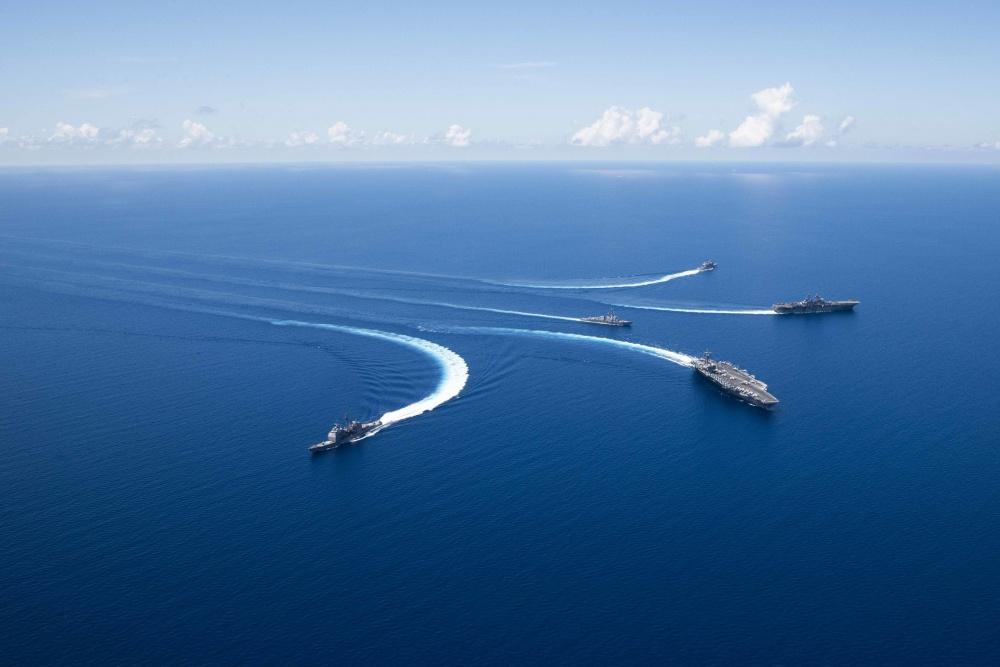There’s no ‘I’ in ‘team’, but is there a ‘US’ in ‘Indo-Pacific’?
Posted By Rod Lyon on December 19, 2019 @ 14:34

Over recent years, Australian governments have made a conscious decision to recast their shorthand description of the strategic region within which they live. In brief, they’ve moved away from describing that region as the ‘Asia–Pacific’ and towards describing it as the ‘Indo-Pacific’.
At first glance, the change looks innocuous enough; the new term seems more inclusive, embracing a rising India, recognising a shifting pattern of regional interdependencies and underlining our new sense of engagement with the Indian Ocean. But along the way, quite unintentionally, something’s been lost—in particular, our understanding of the US’s place in the region.
The 2013 defence white paper [1] was the first to focus on the Indo-Pacific. (The 2009 version didn’t even mention the term.) As it observed at paragraphs 2.4–2.5:
[A] new Indo-Pacific strategic arc is beginning to emerge, connecting the Indian and Pacific Oceans through Southeast Asia. This new strategic construct—explored in both the National Security Strategy and Australia in the Asian Century White Paper—is being forged by a range of factors …
The 2009 Defence White Paper made clear Australia’s enduring interest in the stability of what it called the wider Asia–Pacific region. The Indo-Pacific is a logical extension of this concept, and adjusts Australia’s priority strategic focus to the arc extending from India though [sic] Southeast Asia to Northeast Asia, including the sea lines of communication on which the region depends.
The successful transplantation of the Indo-Pacific into the space formerly occupied by the Asia–Pacific was completed by the 2016 defence white paper, whose 68 references to the term signalled bipartisan acceptance of the change. Other countries in the region were—to varying degrees—gradually drawn to the new terminology. Even the US began to speak of a ‘free and open Indo-Pacific’ and changed the title of its regional military command in Hawaii from USPACOM to USINDOPACOM [2] in May 2018 when Admiral Philip Davidson succeeded Admiral Harry Harris.
When we thought of our region as the Asia–Pacific, the second part of the term was intended to signal our commitment to the idea that the US played an important economic and strategic role in Asia. To talk of Asia at all was to talk of a region where five trans-Pacific US alliances formed the critical hard-power substructure of the regional security architecture, and where the US was the key market for Asian exports.
The term ‘Asia–Pacific’ was itself a perennial reminder of a key Australian interest—maintaining a deep interconnection between Asia’s vibrancy and America’s role as a stabilising superpower. It was a term that pulled Asia eastwards. Simultaneously, it was a term we deployed in Washington to pull the US westwards.
Doubtless, proponents of ‘Indo-Pacific’ believed that the same sense of interconnection would endure under the new moniker, since the second part remained as before. But it hasn’t. When ‘Asia–Pacific’ was replaced with ‘Indo-Pacific’, the sense of the second word shifted, dragged by the first word towards emphasising a shared oceanic theme. If there was a geographic emphasis to the two oceans, it lay at their confluence. The old picture of Asian and American interconnection morphed into a new one, with Southeast Asia and Australia at its centre.
The importance of US strategic primacy faded. After all, the five US alliances were all in East Asia. There aren’t strong strategic linkages between Indian Ocean countries and the US. The best we can say about the Indo-Pacific construct is that it seems to have empowered the rebirth of the ‘Quad’—but the Quad isn’t an alliance. Indeed, even its own members (the US, Japan, India and Australia) sometimes struggle to say exactly what it is.
Putting it baldly, policymakers started thinking about Australia’s strategic priorities in the terms used by the 2013 defence white paper: as ‘the arc extending from India th[r]ough Southeast Asia to Northeast Asia’. No America in that picture, and little enough Pacific. The ‘arc’ no longer pulls Asia eastwards. Centred on Southeast Asia, it pulls northwards and westwards. Centred on China, it pulls broadly southwestwards—the same general direction as the Belt and Road Initiative.
Moreover, the Indo-Pacific construct artificially inflates the strategic importance of Southeast Asia and Australia. Regardless of what we call our region, the strategically important parts of the world are today what they have been for decades: the power cores to be found in Eurasia and North America, and the power balances to be found around the Eurasian rimlands. Those remain distant from Australia whatever label we choose for the region.
The US has, since World War II, offered a commitment to keep those rimland balances stable. In doing so, Australia’s major ally has minimised the likelihood of major-power conflict of a sort that would have rippled into, and disrupted, even Australia’s continental quiescence.
True, US policy has begun to oscillate more disturbingly of late. And that’s certainly not all down to the relabelling of the Asia–Pacific as the Indo-Pacific. America’s role in the world is shifting. A multipolar world is on the rise and US engagement is becoming more selective.
Still, in earlier days the Asia–Pacific label would have reminded us of an old strategic verity: regardless of particular priorities within the region, we want Asia to look east and the US to look west.
Article printed from The Strategist: https://aspistrategist.ru
URL to article: /theres-no-i-in-team-but-is-there-a-us-in-indo-pacific/
URLs in this post:
[1] defence white paper: https://www.defence.gov.au/Whitepaper/2013/
[2] USINDOPACOM: https://www.pacom.mil/About-USINDOPACOM/USPACOM-Area-of-Responsibility/
Click here to print.